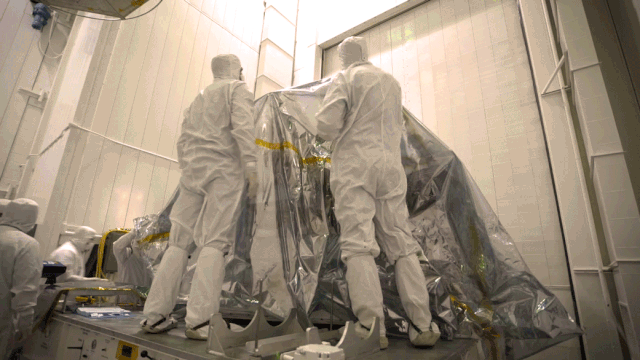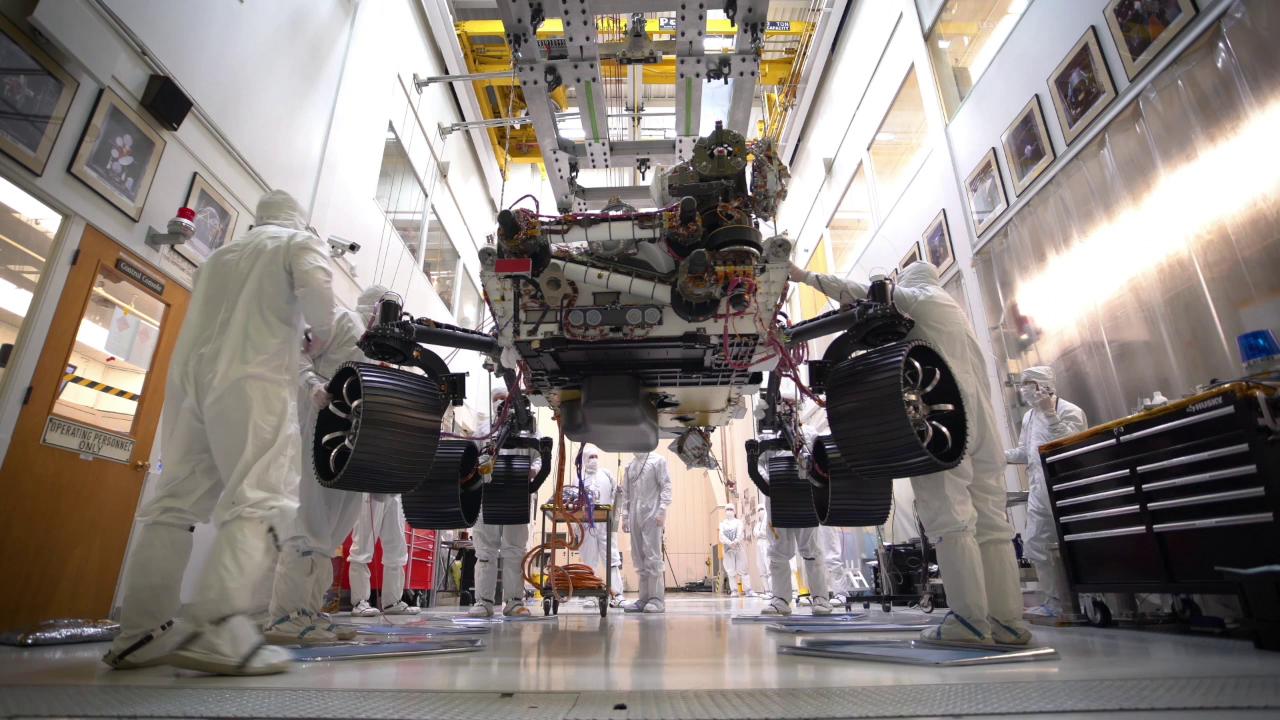Mars 2020 Rover Sheds Its Skin and Stands on Its Own for First Time
The Mars-bound rover is closer to ready for the Red Planet.

NASA's Mars 2020 rover has shed its skin and gained a new arm, and it's now standing on its own six wheels, closer to ready for the Red Planet.
The Mars-bound rover has gone through a few major updates this October. After the rover relocated from the Spacecraft Assembly Facility to the Simulator Building at NASA's Jet Propulsion Laboratory (JPL) to undergo testing, engineers removed the first, inner layer of protective, anti-static foil on the rover to prevent contamination on Mars. In the GIF above, taken on Oct. 4, 2019, you can see a team of engineers in bunny suits (a nickname for their clean room coveralls) "unwrapping" the rover.
After removing the first layer of anti-static foil, the team of engineers wiped down the last layer of foil with 70% isopropyl alcohol. The protective foil and alcohol wipe-down are meant to prevent Earth material from hitching a ride on the rover to Mars and contaminating the surface of the planet.
Related: NASA's Mars Rover 2020 Mission in Pictures
"The Mars 2020 rover will be collecting samples for future return to Earth, so it must meet extraordinary cleanliness measures to avoid the possibility of contaminating Martian samples with terrestrial contaminants," Paul Boeder, a contamination control lead for the Mars 2020 rover at JPL, said in a statement. "To ensure we maintain cleanliness at all times, we need to keep things clean not only during assembly and testing, but also during the moves between buildings for these activities."
Standing on its own
A few days later at JPL, on Oct. 8, the Mars 2020 rover carried its full weight on its six legs and wheels for the first time ever.
"After years of design, analysis and testing, it is fantastic to see the rover on her wheels for the first time," Ben Riggs, a mechanical systems engineer working on Mars 2020 at JPL, said in a statement. "The whole team looks forward to seeing her in the same configuration on Mars in the not-too-distant future."
Get the Space.com Newsletter
Breaking space news, the latest updates on rocket launches, skywatching events and more!

The legs of the rover, which can be identified in the image above as the black tubes above the spacecraft's wheels, are made of titanium. The rover's six wheels are made of aluminum and have cleats, or grousers, that help it get traction on the ground. The wheels currently on the rover are "engineering models" used during this testing phase, and before the rover is launched to Mars, they will be replaced with flight models.
A new arm
The rover updates didn't stop there. On Oct. 22, Maxar Technologies announced that it had delivered the robotic Sample Handling Assembly (SHA), a robotic arm, for the Mars 2020 rover.
The SHA is designed to assess, store and release rock and soil samples collected by the rover on the surface of Mars. The sixth robotic arm from Maxar that will be used on Mars, the SHA will be an important asset for the rover's goal of answering questions about the potential existence, now or in the past, of life on Mars.
NASA's Mars 2020 rover is scheduled to launch to the Red Planet in July of 2020 aboard a United Launch Alliance Atlas V rocket from Space Launch Complex 41 at Cape Canaveral Air Force Station. The rover is set to land on Mars at Jezero Crater on Feb. 18, 2021.
- NASA's Mars 2020 Rover Ready for High-Def Camera Eyes
- NASA Puts Mars 2020 Rover's Space Ride to the Test (Photo)
- Bust a Move! Watch NASA's 2020 Mars Rover Breakdance and Spin
Follow Chelsea Gohd on Twitter @chelsea_gohd. Follow us on Twitter @Spacedotcom and on Facebook.
Join our Space Forums to keep talking space on the latest missions, night sky and more! And if you have a news tip, correction or comment, let us know at: community@space.com.

Chelsea “Foxanne” Gohd joined Space.com in 2018 and is now a Senior Writer, writing about everything from climate change to planetary science and human spaceflight in both articles and on-camera in videos. With a degree in Public Health and biological sciences, Chelsea has written and worked for institutions including the American Museum of Natural History, Scientific American, Discover Magazine Blog, Astronomy Magazine and Live Science. When not writing, editing or filming something space-y, Chelsea "Foxanne" Gohd is writing music and performing as Foxanne, even launching a song to space in 2021 with Inspiration4. You can follow her on Twitter @chelsea_gohd and @foxannemusic.









